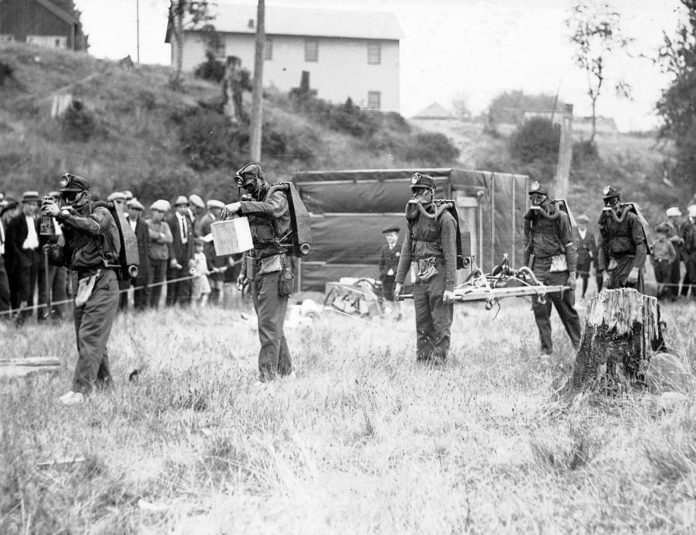Last week’s column featured a photo of the Newcastle team at the Western Washington Mine Rescue and First Aid Meet held in Carbonado on August 9, 1924. This image shows another rescue team, likely Black Diamond’s, demonstrating how workers might enter a smoke-filled chamber which mimicked underground mine conditions following an explosion.
The first miner on the left is carrying a methane detector, a reliable tool for revealing the presence of explosive gasses. The next miner carried a box, which likely contained a canary, as that system was still in use. A canary was particularly vulnerable to gasses or lack of oxygen and was historically used as an early warning system to alert coal miners to hazardous conditions.
The “smoke-house” as it was called, was developed as a simulated underground coal mine containing a dense atmosphere filled with stifling black smoke from burning coal and automobile tires. To counter the toxic fumes the rescue teams were equipped with Gibbs oxygen breathing apparatus.
Like scuba gear of today, the Gibbs equipment provided a steady stream of oxygen plus an absorber to render harmless carbon dioxide expelled from the lungs. After spending three minutes in the smoke-house, Dr. A.L. Murray of the U.S. Bureau of Mines was on hand to take the pulse of mine rescuers, and if within limits release them to reenter the chamber.
The competition was an attempt by mine owners and state officials to spur interest in developing improved safety measures for the dangerous business of underground coal mining.
As a follow-up article in the Aug. 10thSeattle Times noted, “An efficient mine rescue team is the pride of every coal camp and its main dependence in case of mine disasters.”
This photo comes courtesy of Jerry & Lynda English with research provided by JoAnne Matsumura, an Issaquah historian.







